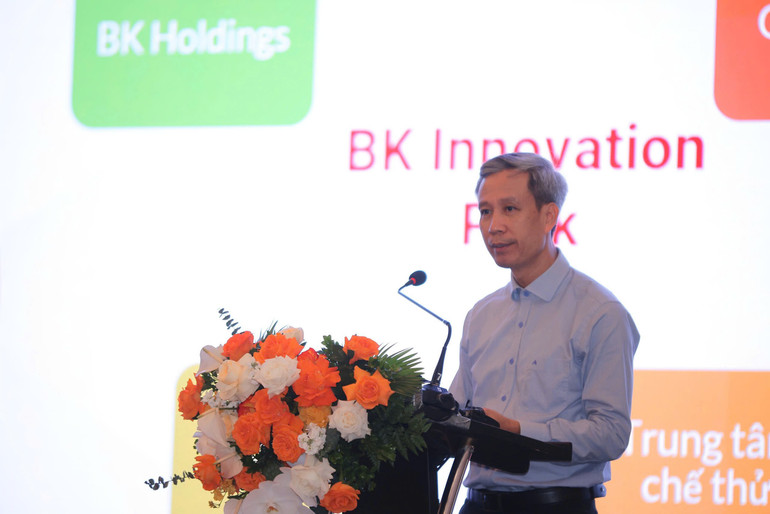
At the Forum on the Future of Science , Technology, Innovation and Digital Transformation organized by the Ministry of Science and Technology on the morning of August 29, towards the 80th Anniversary of the National Day of the Socialist Republic of Vietnam, many experts and managers discussed the vision for the next decade for the science and technology sector, emphasizing the shaping of strategic thinking in the new context. A prominent content is the issue of cooperation between the State-institutes, schools-enterprises.
Professor, Dr. Le Anh Tuan, Party Secretary, Chairman of the University Council, Hanoi University of Science and Technology affirmed that it is necessary to strongly promote this model because in the context of the 4.0 industrial revolution and the era of knowledge economy , no single entity can shoulder the entire chain of innovation by itself. Linking the "three houses" becomes an important key to technology development.
Professor Le Anh Tuan cited the "3-house" cooperation model in some developed countries, showing that each country has its own approach depending on the economic, cultural and political context.

In Korea, the government invests heavily in national R&D programs and supports technology parks; large corporations such as Samsung and LG work closely with universities and research institutes to develop new products; institutes and schools play a central role in applied research and technology transfer.
For example, POSCO invested about $2 billion in Pohang University of Science and Technology (POSTECH) with 2% of its annual R&D budget dedicated to joint research; Samsung invested $50-100 million/year in Sungkyunkwan University (SKKU) since 1997 to fund the construction of a research center and scholarships; the Korea Institute of Science and Technology cooperated with Samsung to develop semiconductor technology and artificial intelligence, with financial support from the government.
As a result of this alliance, Korea has achieved rapid growth in high-tech industries, becoming one of the leading countries in chip and electronics production. Its high R&D/GDP ratio contributes to innovation-based growth. POSTECH University leads biotech research, investing $50 million in bio-ventures in the US. SKKU University leads global graphene patents and develops world-class pharmaceutical centers.
In Canada, the government provides funding through organizations such as Mitacs and CANSSI to support interdisciplinary research projects and student internships; businesses contribute about 50% of project costs, to cooperate with universities, ensuring research meets real needs; institutes and universities provide experts and research facilities, and train students through internship programs.
The Mitacs internship program connects students with companies to solve real-world problems, such as research in renewable energy and artificial intelligence.
The main outcomes of this partnership are to enhance students’ practical skills, promote innovation in industry and improve research capacity. Canada is recognized as a country that has achieved local success with this trilateral partnership model but lacks national scale, leading to lower efficiency.
From those international experiences, Professor, Dr. Le Anh Tuan proposed a three-party linkage model for Vietnam in the new situation. Accordingly, the State plays a creative role through policy making, strategic orientation, investment in research infrastructure and technology ordering; Research institutes and universities are places to create new knowledge, train high-quality human resources and develop basic technology; enterprises are market drivers, possess financial resources, organize production and product distribution.
He emphasized that research products will not be viable if they are not commercialized and applied to serve the economy and society. Therefore, commercialization of research results is an important measure of scientific and technological activities. Creative research products cannot be brought to market without the role of the State and enterprises in investing in product completion, incubation and marketization.
To promote the connection of the "three houses", an open innovation ecosystem is needed, in which the role of innovation ecosystems at the institute and school levels needs to be promoted. Here, science and technology development funds and venture capital funds need to be encouraged to be formed from the self-funded sources of the facilities and the counterpart funds of the State and financial resources of business cooperation. When this fund is used effectively, it will create an environment for research, product innovation and motivation for the team of researchers as well as attract talent.
In addition to the science and technology development fund, it is necessary to equip shared fab-labs (testing centers). Scientists and research groups can register to use fab-labs along with financial support from the fund for purchasing consumables for the product completion process...
Venture capital funds, investment funds and fab-labs need to organize at multiple levels and without limiting the scope of funding, creating an open ecosystem with data connection to avoid duplicate funding and support.
Source: https://nhandan.vn/lien-ket-3-nha-tao-nen-tang-phat-trien-cong-nghe-va-thuong-mai-hoa-ket-qua-nghien-cuu-post904671.html



![[Photo] Prime Minister begins trip to attend SCO Summit 2025 in China](https://vphoto.vietnam.vn/thumb/1200x675/vietnam/resource/IMAGE/2025/8/31/054128fff4b94a42811f22b249388d4f)
![[Photo] Chairman of the National People's Congress of China Zhao Leji begins official visit to Vietnam](https://vphoto.vietnam.vn/thumb/1200x675/vietnam/resource/IMAGE/2025/8/31/fcfa5a4c54b245499a7992f9c6bf993a)


![[Infographic] Traditional relations and special friendship between Vietnam and Cuba](https://vphoto.vietnam.vn/thumb/1200x675/vietnam/resource/IMAGE/2025/8/31/c4c2b14e48554227b4305c632fc740af)
![[Photo] First Secretary and President of Cuba begins State visit to Vietnam](https://vphoto.vietnam.vn/thumb/1200x675/vietnam/resource/IMAGE/2025/8/31/f169c1546ec74be7bf8ccf6801ee0c55)












![[Photo] Chairman of the National People's Congress of China Zhao Leji begins official visit to Vietnam](https://vphoto.vietnam.vn/thumb/402x226/vietnam/resource/IMAGE/2025/8/31/fcfa5a4c54b245499a7992f9c6bf993a)


![[Photo] First Secretary and President of Cuba begins State visit to Vietnam](https://vphoto.vietnam.vn/thumb/402x226/vietnam/resource/IMAGE/2025/8/31/f169c1546ec74be7bf8ccf6801ee0c55)
![[Infographic] Traditional relations and special friendship between Vietnam and Cuba](https://vphoto.vietnam.vn/thumb/402x226/vietnam/resource/IMAGE/2025/8/31/c4c2b14e48554227b4305c632fc740af)


































































Comment (0)